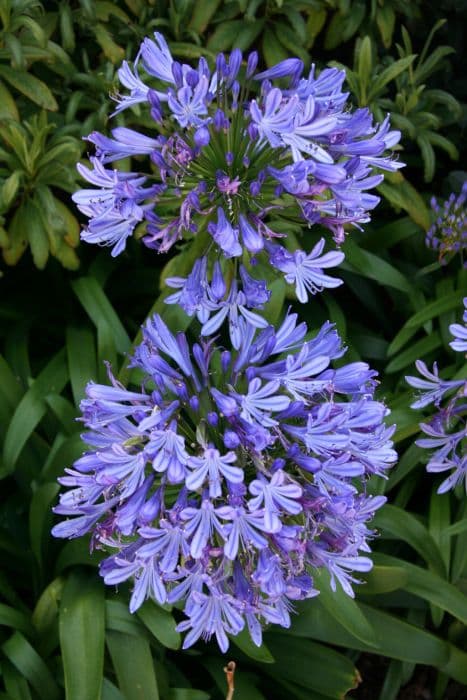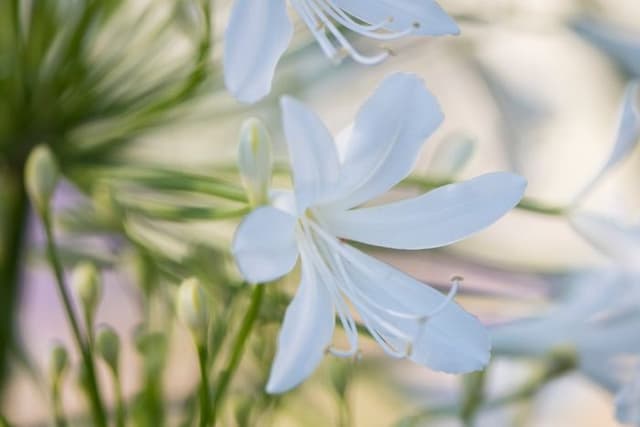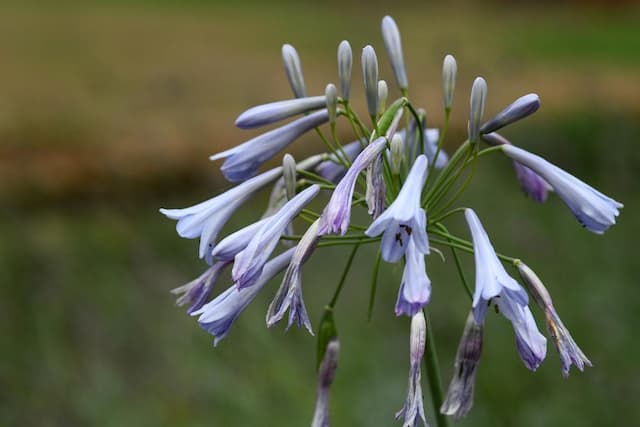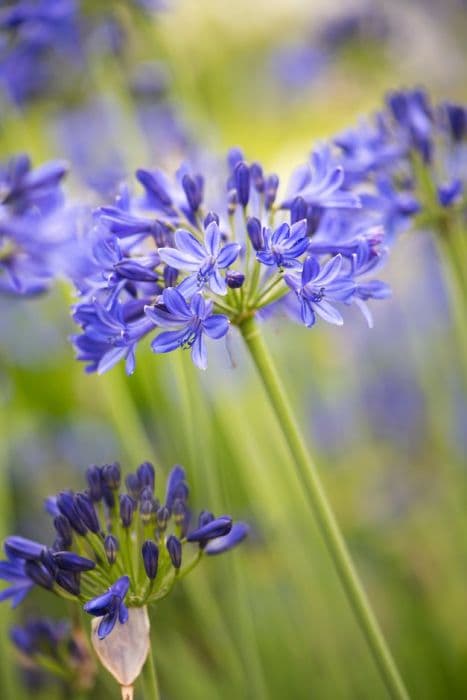African Lily Agapanthus 'Crystal'

ABOUT
The Agapanthus 'Crystal', commonly known as the African Lily or Lily of the Nile, is an ornamental plant known for its lush foliage and striking floral display. The plant is characterized by its graceful, strap-like green leaves that form a dense clump, creating an attractive foliage base from which the flower stalks arise. The standout feature of the Agapanthus 'Crystal' is its flowers. They bloom in a pristine white color, giving the variety its 'Crystal' name due to the clear, crisp look of the blossoms. These flowers are arranged in large, rounded clusters, also known as umbels, at the top of tall, upright stalks that tower above the foliage. Each cluster is composed of multiple individual trumpet-shaped flowers, which are oriented outward from the center of the umbel, creating a starburst effect. The African Lily's flowers are cherished for their elegance and simplicity, making them popular in gardens where they can provide a dramatic focal point. They also attract various pollinators, adding to the plant's ornamental value. The contrast between the dark green leaves and the bright white flowers of 'Crystal' can add a stunning visual interest to any setting where the specific size of the plant is suitable.
About this plant
 Names
NamesFamily
Amaryllidaceae
Synonyms
African Lily, Lily of the Nile, Love Flower
Common names
Agapanthus 'Crystal'
 Toxicity
ToxicityTo humans
Agapanthus, commonly known as Lily of the Nile or African Lily, can be toxic to humans if ingested. The toxicity of the plant is due to the presence of certain chemical compounds such as saponins and possibly others, which can cause symptoms like nausea, vomiting, and diarrhea. Ingesting large amounts of the plant can be more severe and may result in abdominal pain, salivation, and even rare cases of tremors or cardiac arrhythmia, though reports of such severe symptoms are relatively uncommon. It's important to handle the plant with care and ensure that it's out of reach of children who might accidentally ingest it.
To pets
Agapanthus, commonly known as Lily of the Nile or African Lily, is toxic to pets, including dogs and cats. The ingestion of any part of the plant can lead to symptoms such as vomiting, diarrhea, abdominal pain, and drooling. The toxic principles in Agapanthus, which include saponins among other potential compounds, can cause these gastrointestinal symptoms. In severe cases, more significant effects such as trembling, lethargy, and cardiac issues can occur. It is essential to prevent pets from accessing this plant to avoid potential poisoning. If you suspect your pet has ingested any part of an Agapanthus, it is critical to contact your veterinarian promptly.
 Characteristics
CharacteristicsLife cycle
Perennials
Foliage type
Evergreen
Color of leaves
Green
Flower color
Blue
Height
2 feet (60 cm)
Spread
2 feet (60 cm)
Plant type
Bulb
Hardiness zones
8
Native area
South Africa
Benefits
 General Benefits
General Benefits- Ornamental Appeal: Provides gardeners with striking ornamental blooms that enhance the visual appeal of landscapes and gardens.
- Drought Tolerance: Requires minimal watering once established, making it suitable for regions with low water availability or for water-conservative gardening.
- Low Maintenance: Does not require frequent care or complicated maintenance routines, making it a convenient choice for busy gardeners.
- Attracts Pollinators: Flowers of the Agapanthus 'Crystal' attract bees and butterflies, which are beneficial for pollinating gardens.
- Long Blooming Period: Offers a lengthy blooming season, generally from early summer to early fall, providing color for an extended period.
- Border and Container Planting: Suits being planted in borders for garden definition or in containers for flexibility and accentuation in garden design.
- Hardiness: Relatively hardy against common garden pests and diseases, reducing the need for chemical interventions.
- Good Cut Flowers: Stems and flowers are often used in floral arrangements due to their durability and appealing form.
- Architectural Structure: The strappy leaves and tall flower spikes add an architectural element to garden designs.
- Variety of Uses: Suitable for mass planting, as a specimen plant, or blended into mixed borders alongside other plants.
 Medical Properties
Medical PropertiesThis plant is not used for medical purposes.
 Air-purifying Qualities
Air-purifying QualitiesThis plant is not specifically known for air purifying qualities.
 Other Uses
Other Uses- Biodegradable Dyes: The blue to violet shades of Agapanthus flowers can be used to produce natural, biodegradable dyes for fabrics, papers, and crafts.
- Erosion Control: Due to their dense root systems, Agapanthus can be planted to help stabilize soil and prevent erosion on slopes or banks.
- Edible Flowers: Though not widely known, the flowers of Agapanthus are edible and can be used to add a colorful garnish to salads and desserts.
- Floral Arrangements: The long-lasting flowers of Agapanthus lend themselves to be used in both fresh and dried floral arrangements or as ornamental displays.
- Ink Production: The pigments from Agapanthus flowers can be used in the production of natural inks for art and writing purposes.
- Photographic Subject: With their striking appearance, Agapanthus plants are often used as photogenic subjects in botanical and landscape photography.
- Garden Borders: Agapanthus can serve as a natural border or hedge in gardens, providing structure and a burst of color when in bloom.
- Companion Planting: Agapanthus can be used in companion planting to contrast with other plants due to their specific growth pattern and flowering season.
- Ice Cubes: Petals of Agapanthus flowers can be frozen in ice cubes to create visually appealing beverages for special occasions.
- Culinary Decoration: The unique shape of Agapanthus flowers makes them suitable for decorative purposes in haute cuisine to create visually captivating dishes.
Interesting Facts
 Feng Shui
Feng ShuiThe African Lily is not used in Feng Shui practice.
 Zodiac Sign Compitability
Zodiac Sign CompitabilityThe African Lily is not used in astrology practice.
 Plant Symbolism
Plant Symbolism- Love Letters: The name "Agapanthus" comes from the Greek words 'agape', meaning love, and 'anthos', meaning flower. The 'Crystal' variety, with its pure and clear connotations, amplifies this message of affection.
- Beauty: Often considered a striking beautiful plant with its lush foliage and stunning blue or white flowers, the 'Crystal' variety is associated with beauty and appreciation of it.
- Constancy and Endurance: The evergreen nature of some Agapanthus 'Crystal' varieties symbolizes lasting and enduring nature in relationships or connections.
- Fertility: The Agapanthus is sometimes associated with fertility due to its prolific seed production, suggesting growth and development.
- Good Fortune: The full and rounded shape of its flower heads can symbolize prosperity and good fortune.
 Water
WaterFor the Lily of the Nile, commonly known as Agapanthus 'Crystal', watering should be done deeply, ensuring the water reaches the roots, but allowing the soil to dry out between waterings. During the growing season in spring and summer, this typically means watering once a week, with about 1-2 gallons per plant, depending on the size and the weather conditions. Reduce watering frequency in fall and winter to every other week or less, as the plant requires less moisture when it's not actively growing. Over-watering can lead to root rot, so it is essential to ensure good drainage and check the soil moisture before watering again.
 Light
LightThe Lily of the Nile thrives best in full sun to partial shade conditions. It needs at least six hours of direct sunlight daily to bloom well. However, in extremely hot climates, providing some afternoon shade can prevent leaf scorching. The ideal spot for this plant would be in an area where it receives morning sun and some protection from the intense heat of the afternoon.
 Temperature
TemperatureThe Lily of the Nile can tolerate temperatures as low as 50°F, but it prefers to grow in conditions where the temperatures range between 60°F and 70°F. During winter, it's essential to protect the plant from frost, which can damage or kill it, as it can only withstand temperatures down to about 20°F. The ideal temperature range for the Agapanthus 'Crystal' lies within these warmer conditions to thrive and produce its characteristic blooms.
 Pruning
PruningPruning the Lily of the Nile is essential to remove spent flowers and encourage new growth. It's best to prune the plant after it has finished blooming, which is typically late summer or early fall. Cut back the flowering stalks to the base to promote next year's growth. Additionally, remove any damaged or dead foliage to maintain the plant's appearance and health. Pruning once a year is generally sufficient for this perennials' upkeep.
 Cleaning
CleaningAs needed
 Soil
SoilThe best soil mix for Lily of the Nile (Agapanthus 'Crystal') is well-draining, loamy soil enriched with organic matter. A pH of 6.0 to 8.0 is suitable for this plant. Amending garden soil with compost and a bit of sand can improve drainage and provide the necessary nutrients.
 Repotting
RepottingLily of the Nile should be repotted every 2-3 years to refresh the soil and allow for growth. It's best to repot in spring before new growth begins.
 Humidity & Misting
Humidity & MistingLily of the Nile prefers moderate humidity levels but is quite adaptable. It does not require any special humidity adjustments in a typical home or garden setting.
 Suitable locations
Suitable locationsIndoor
Place Lily of the Nile in a bright, sunny spot.
Outdoor
Plant in sun or part-shade; protect from harsh winds.
Hardiness zone
6-11 USDA
 Life cycle
Life cycleAgapanthus 'Crystal', commonly known as the African Lily or Lily of the Nile, begins its life cycle with seed germination, which occurs in warm, moist soil conditions. Once the seedlings emerge, they grow into vegetative plants with strap-shaped leaves, forming clumps from which arise tall flowering stalks. The plants mature and produce spherical clusters of tubular white flowers, typically during the summer months. After flowering, seed pods develop, which eventually dry and release the seeds, completing the reproductive cycle. In cooler climates or during winter months, the plant enters a period of dormancy where growth slows significantly. With the return of warmer temperatures, the cycle recommences with new vegetative growth from the plant's rhizome or from the germinated seeds.
 Propogation
PropogationPropogation time
Spring-Early Summer
Agapanthus 'Crystal', commonly known as Lily of the Nile, is typically propagated through division. The best time for this is in the spring or early fall, when the plant is not in active bloom. To propagate by division, carefully dig up the clump of Agapanthus and gently separate it into smaller sections, ensuring that each section has at least one or two healthy looking growth points, which are often referred to as "fans". These individual sections can then be replanted at the same depth they were growing previously, spaced approximately 18 inches to 2 feet (45 to 60 centimeters) apart to allow room for growth. Water the newly planted divisions well to help establish them. This method of propagation is efficient for expanding your garden with new plants or rejuvenating older clumps that have become too dense and begun to flower poorly.









![African lily [Double Diamond]](/_next/image?url=https%3A%2F%2Fplants-admin.emdemapps.com%2Fimages%2Fplants%2F%2Fimages%2F604b558c4357a.png&w=640&q=75)